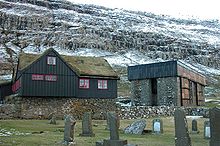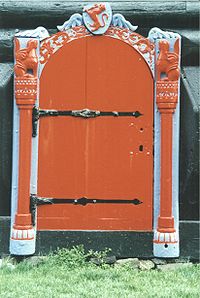
Kirkjubøargarður
Encyclopedia



Farm
A farm is an area of land, or, for aquaculture, lake, river or sea, including various structures, devoted primarily to the practice of producing and managing food , fibres and, increasingly, fuel. It is the basic production facility in food production. Farms may be owned and operated by a single...
itself has always been the largest in the Faroe Islands
Faroe Islands
The Faroe Islands are an island group situated between the Norwegian Sea and the North Atlantic Ocean, approximately halfway between Scotland and Iceland. The Faroe Islands are a self-governing territory within the Kingdom of Denmark, along with Denmark proper and Greenland...
.
The old farmhouse
Farmhouse
Farmhouse is a general term for the main house of a farm. It is a type of building or house which serves a residential purpose in a rural or agricultural setting. Most often, the surrounding environment will be a farm. Many farm houses are shaped like a T...
of Kirkjubøur dates back to the 11th century. It was the episcopal residence and seminary of the Diocese of the Faroe Islands, from about 1100. The legend says, that the wood for the block houses came as driftwood
Driftwood
Driftwood is wood that has been washed onto a shore or beach of a sea or river by the action of winds, tides, waves or man. It is a form of marine debris or tidewrack....
from Norway
Norway
Norway , officially the Kingdom of Norway, is a Nordic unitary constitutional monarchy whose territory comprises the western portion of the Scandinavian Peninsula, Jan Mayen, and the Arctic archipelago of Svalbard and Bouvet Island. Norway has a total area of and a population of about 4.9 million...
and was accurately bundled and numbered, just for being set up. Note, that there is no forest in the Faroes and wood is a very valuable material. Many such wood legends are thus to be found in Faroese history
History of the Faroe Islands
-Pre-Norse history:The early details of Faroese history are rather nebulous. It is possible that Saint Brendan, an Irish monk sailed past the islands during his North Atlantic voyage in the 6th century...
.
The oldest part is a so-called roykstova (reek parlour, or smoke room). Perhaps it was moved one day, because it does not fit to its foundation. Another ancient room is the loftstovan (loft room). It is supposed that Bishop Erlendur wrote the "Sheep Letter" here in 1298. This is the earliest document of the Faroes we know today. It is the statute concerning sheep breeding on the Faroes.
Today the room is the farm's library. The stórastovan (large room) is from a much later date, being built in 1772.
Though the farmhouse is a museum
Museum
A museum is an institution that cares for a collection of artifacts and other objects of scientific, artistic, cultural, or historical importance and makes them available for public viewing through exhibits that may be permanent or temporary. Most large museums are located in major cities...
, the 17th generation of the Patursson Family, which has occupied it since 1550, is still living here. Shortly after the Reformation in the Faroe Islands in 1538, all the real estate of the Catholic Church was seized by the King of Denmark. This was about half of the land in the Faroes, and since then called King's Land (kongsjørð). The largest piece of King's Land was the farm in Kirkjubøur due to the above-mentioned Episcopal residence. This land is today owned by the Faroese government, and the Paturssons are tenants
Leasehold estate
A leasehold estate is an ownership of a temporary right to land or property in which a lessee or a tenant holds rights of real property by some form of title from a lessor or landlord....
from generation to generation. It is always the oldest son, who becomes King's Farmer, and in contrast to the privately owned land, the King's Land is never divided between the sons.
The farm holds sheep, cattle and some horses. It is possible to get a coffee here and buy fresh mutton and beef directly from the farmer. In the winter season there is also hare hunting for the locals. Groups can rent the roykstovan for festivities and will be served original Faroese cuisine
Faroese cuisine
Important parts of Faroese cuisine are lamb and fish, due to the proximity to the ocean. Traditional food from the Faroe Islands include skerpikjøt , seafood, whale meat, blubber, garnatálg, puffins, potatoes and few fresh vegetables....
.
Other famous buildings directly by the farmhouse are the Magnus Cathedral
Magnus Cathedral
Magnus Cathedral is a ruined cathedral in the town of Kirkjubøur in the Faroe Islands. It was built in by Bishop Erlendur about the year 1300, but the building was never completed. The cathedral is to this day in an unfinished state; the building has never had a roof. Magnus Cathedral is the...
and the Saint Olav's Church, which also date back to the mediaeval period. All three together represent the Faroe Island's most interesting historical site.
People
Famous people, who were born here or lived here for a period:- Sverre I of Norway (1151–1202), grew up here and went to the priest school.
- Bishop Erlendur (?–1308), wrote the Sheep Letter and built the Magnus Cathedral.
- Súsanna Helena PaturssonHelena PaturssonSúsanna Helena Patursson was a Faroese actress and writer, and the first political feminist in the country. She also wrote the first play in the Faroese language...
(1864–1916), first feminist of the Faroes. - King's farmer Jóannes PaturssonJóannes PaturssonJóannes Patursson was a Faroese nationalist leader and poet.He was the great-grandson of the Faroese national hero Nólsoyar Páll. His brother Sverre Patursson was an important writer and his sister Susanna Helena Patursson the first feminist of the Faroe Islands.-Background:Jóannes was born in...
(1866–1946), oldest brother of Helena, nationalist leader and writer. - Sverre Patursson (1871–1960) brother of Helena and Jóannes, writer, journalist and environmentalist.
- Erlendur PaturssonErlendur PaturssonErlendur Patursson was a Faroese politician and writer.Erlendur was born in 1913 in Kirkjubøur. He was the son of the politician Jóannes Patursson....
(1913–1986), son of Jóannes, writer and nationalist politician. - Tróndur PaturssonTróndur PaturssonTróndur Patursson is a Faroese painter, sculptor, and glass artist. He was educated in Norway and was initially a sculptor. He has since become better known as a painter and glass artist....
(born 1944), great-grandson of Jóannes, artist and adventurer.
External links
- Patursson.com — website of the Patursson family (in English and Faroese)

